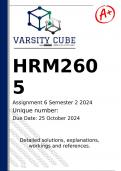HRM260
5
Assignment 6 Semester 2 2024
Unique number:
Due Date: 25 October 2024
Detailed solutions, explanations,
workings and references.
, +27 81 278 3372
QUESTION 1
1.1.
1.1.1.
As the consultant who administered the job satisfaction survey, it is crucial to
analyze the findings in the table to provide Godfrey with insights into the root
causes of the high absenteeism and turnover rates at the Cape Town plant. The
survey results indicate significant dissatisfaction among employees across
various aspects of their job, which likely contributes to these issues.
1. The Job Itself (40% satisfied, 60% dissatisfied): A majority of the employees
are dissatisfied with their roles, as evidenced by the 60% dissatisfaction rate. This
could indicate that the job is monotonous, lacks meaningful engagement, or fails
to provide opportunities for autonomy and creativity. Employees may feel that the
tasks they perform do not challenge them, resulting in boredom and
disengagement. Another factor could be that the job lacks clarity or that
employees are not well-matched to their roles, which can lead to frustration and
poor performance.
2. Relationships with Co-workers (49% satisfied, 51% dissatisfied): The split
between satisfied and dissatisfied employees regarding their relationships with
co-workers suggests that there are issues related to workplace culture and
teamwork. Employees may be experiencing conflict, poor communication, or a
lack of collaboration among team members. A lack of camaraderie or mutual
support in the workplace can diminish job satisfaction and create a tense working
environment, contributing to higher absenteeism and turnover.
3. Immediate Supervisor (45% satisfied, 55% dissatisfied): More than half of
the employees are dissatisfied with their immediate supervisors, which can
indicate problems with leadership and management styles. Employees may feel
that their supervisors are not providing adequate support, guidance, or
Varsity Cube 2024 +27 81 278 3372




